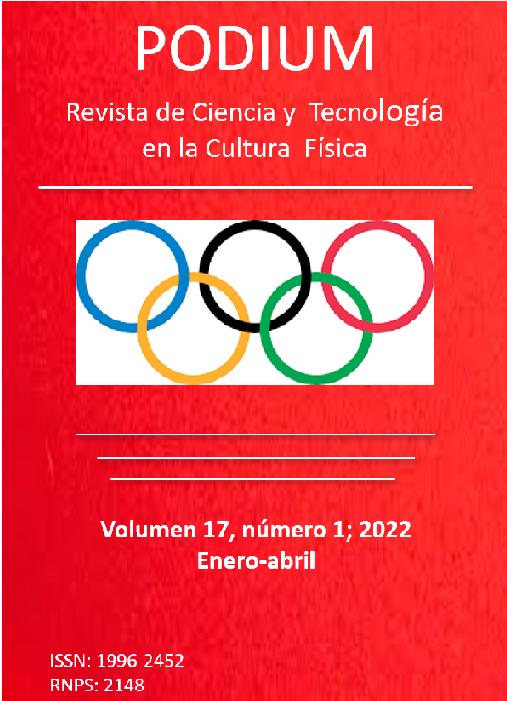Diferencias biomecánicas en la patada chigo-Chagüi con pierna delantera entre taekwondocas principiantes y avanzados/Biomechanical differences in the chigo-Chagüi kick with the front leg in female beginner and advanced taekwondo fighters
Contenido principal del artículo
Resumen
El análisis de la técnica deportiva entre diferentes niveles de rendimiento sirve para establecer comparaciones metodológicas que tributan al perfeccionamiento del rendimiento motriz especializado, incluidos los deportes eminentemente técnico-tácticos. En tal sentido, el objetivo de la investigación es analizar las diferencias biomecánicas entre deportistas profesionales y amateurs de taekwondo en la realización de la patada Chigo-Chagüi con pierna delantera. Se estudiaron dos grupos independientes, Deportistas Principiantes (DPRI) 15 principiantes y Deportistas Profesionales (DPRO): 15 avanzados o profesionales), se estudiaron indicadores de Velocidad, Ángulo de Flexión y Centro de Gravedad y se estableció una comparación. Se determinó un ángulo inicial de DPRO =28,4° y DPRI: 27,34° (p=0.309) y un ángulo de impacto de DPRI= 117,93º y DPRO=129,2º (p=0.001) y un ángulo final de DPRI=31,34º y DPRO=26,34º (p=0.057), con un tiempo de ejecución de la patada de DPRO=1312ms y DPRI=1462 ms (p=0.009), una velocidad máxima de DPRO=6,86 m/s y DPRI=5,47 m/s (p=0.003) y una aceleración promedio de DPRO=48,35 m/s2 y DPRI=36,55 m/s2 (p=0.029), siendo el centro de gravedad para el punto de impacto en Eje X sin diferencias significativas (p=0.506) y en el Eje y con diferencias significativas entre grupos independientes (p=0.029). Las diferencias entre deportistas avanzados y principiantes en la patada chigo-chagüi con pierna delantera suelen ser notables en la mayoría de los indicadores analizados, siendo el nivel del atleta un indicador que permite describir las deficiencias técnicas.
Descargas
Detalles del artículo
Citas
Akhmad, I., Nugraha, T., & Sembiring, P. (2021). Speed, Agility, and Quickness (SAQ) training of the circuit system: How does it affect kick speed and agility of junior taekwondo athletes?. Journal Sport Area, 6(2), 175-182. doi:10.25299/sportarea.2021.vol6(2).6433
da Silva Santos, J. F., Loturco, I., & Franchini, E. (2018). Relationship between frequency speed of kick test performance, optimal load, and anthropometric variables in black-belt taekwondo athletes. Ido Movement for Culture. Journal of Martial Arts Anthropology, 18(1), 39-44. doi:10.14589/ido.18.1.6
Ervilha, U. F., Fernandes, F. D., Souza, C. C., & Hamill, J. (2020). Reaction time and muscle activation patterns in elite and novice athletes performing a taekwondo kick. Sports biomechanics, 19(5), 665-677. doi:10.1080/14763141.2018.1515244
Granda, C. A., Loachamin, E. M., & Arla, S. M. (2016). Biomechanical analysis of the Taekwondo Ap-Chagui kick. Lecturas: Educación Física y Deportes, 21(218), 1-7. https://www.efdeportes.com/efd218/biomechanical-analysis-of-the-taekwondo.htm
Kazemi, M., Waalen, J., Morgan, C., & White, A. R. (2006). A profile of Olympic taekwondo competitors. Journal of sports science & medicine, 5(CSSI), 114. https://www.jssm.org/jssm-05-CSSI1-114.xml%3EFulltext
León, S., Calero, S., & Chávez, E. (2016). Morfología funcional y biomecánica deportiva (2E ed.). Quito, Ecuador: Editorial de la Universidad de las Fuerzas Armadas ESPE.
Loachamin, E. M., Mena, F. M., Durán, E. E., & Maqueira, G. d. (2017). Diferencias biomecánicas en la patada ap chagüi entre taekwondocas de cinturón blanco y negro. Revista Cubana de Investigaciones Biomédicas, 36(2), 159-168. http://scielo.sld.cu/scielo.php?pid=S0864-03002017000200013&script=sci_arttext&tlng=en
Luigi T. Bercades, & Willy Pieter. (2007). Un análisis biomecánico de la patada descendente modifi cada de taekwondo. Revista de Artes Marciales Asiáticas, 2(1), 28-39. http://revpubli.unileon.es/ojs/index.php/artesmarciales/article/view/282/239
Marlene J Adrian, & John M Cooper. (1995). Biomechanics of Human Movement. WCB. Brown a BenchmarkPub. Iowa: WCB Brown & Benchmark.
Martinez, C. A., & Escobar, Y. P. (2017). Sistema de ejercicios para el perfeccionamiento de la velocidad de ejecución simple y compleja en acciones ofensivas del taekwondo en atletas escolares de la EIDE provincia las Tunas. Revista Boletín Redipe, 6(1), 174-192. http://revista.redipe.org/index.php/1/article/view/187
McGinnis, P. M. (2013). Biomechanics of sport and exercise. Human Kinetics. New York: Human Kinetics.
Ojeda-Aravena, A. P., Azócar-Gallardo, J., Hérnandez-Mosqueira, C., & Herrera-Valenzuela, T. (2020). Relación entre la prueba de agilidad específica en taekwondo (tsat), la fuerza explosiva y la velocidad líneal en 5-m atletas de taekwondo de ambos sexos. Retos, 39, 84-89., 39, 84-89. doi:10.47197/retos.v0i39.78395
Paramitha, S. T., Rosadi, T. Y., Ramadhan, M. G., & Suwanta, D. M. (2020). The Influence of Flexibility Training on the Accuracy of the Dollyo Chagi Kick in Taekwondo Martial Arts. In 4th International Conference on Sport Science, Health, and Physical Education (ICSSHPE 2019) (4th International Conference on Sport Science, Health, and Physical Education (ICSSHPE 2019).21, págs. 317-320. Atlantis Press. https://www.atlantis-press.com/article/125934806.pdf
Saransig, D. D., López, A. P., & Aldaz, E. M. (2021). Diferencias biomecánicas en el taekwondo entre la categoría clasificado y novato realizando la patada mondolyo furyo chagui. Lecturas: Educación Física y Deportes, 26(276), 75-89. doi:10.46642/efd.v26i276.2918
Swandana, A., Sugiharto, S., & Wahyu, I. S. (2021). Development of Reaction Speed and Endurance Training Tools for Taekwondo Kick Speeds Using Pyongyo. Journal of Physical Education and Sports, 10(1), 8-16. https://journal.unnes.ac.id/sju/index.php/jpes/article/view/44385
Tacan, E. J., Werz, D. N., & Cevallos, E. C. (2021). Insistencia pasiva dinámica y contracción maximal: influencia en la flexibilidad del split en karate. PODIUM-Revista de Ciencia y Tecnología en la Cultura Física, 16(2), 1-13. http://podium.upr.edu.cu/index.php/podium/article/view/1084
Tipán, M. G., Quichimbla, H. V., Morales, C., Apolo, E. G., Aldaz, E. M., & Rojas, M. P. (2017). Integrated training vs traditional training in senior taekwondo practitioners. Lecturas: Educación Física y Deportes, 21(224), 1-16. https://efdeportes.com/efd224/integrated-training-in-senior-taekwondo.htm
WTF, W. T. (2020). Competition Rules & Interpretation. Seoul, Korea: World Taekwondo Federation. http://www.worldtaekwondo.org/viewer_pdf/external/pdfjs-2.1.266-dist/web /viewer.html?file=http://www.worldtaekwondo.org/att_file/documents/WT%20Competition%20Rules_Interpretation%20(October%201,%202020).pdf


